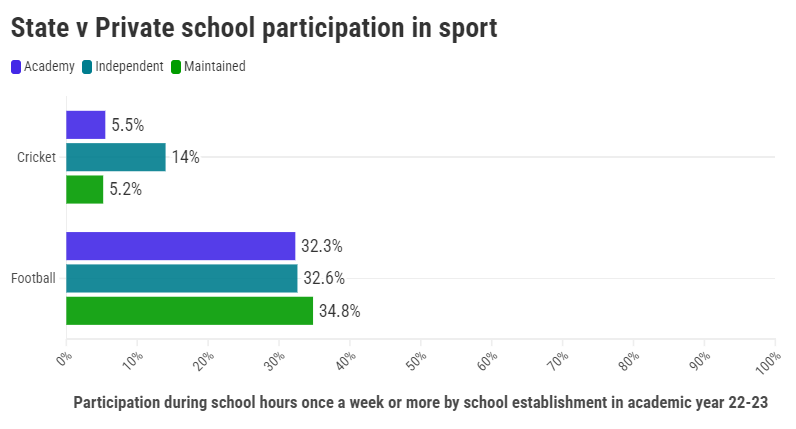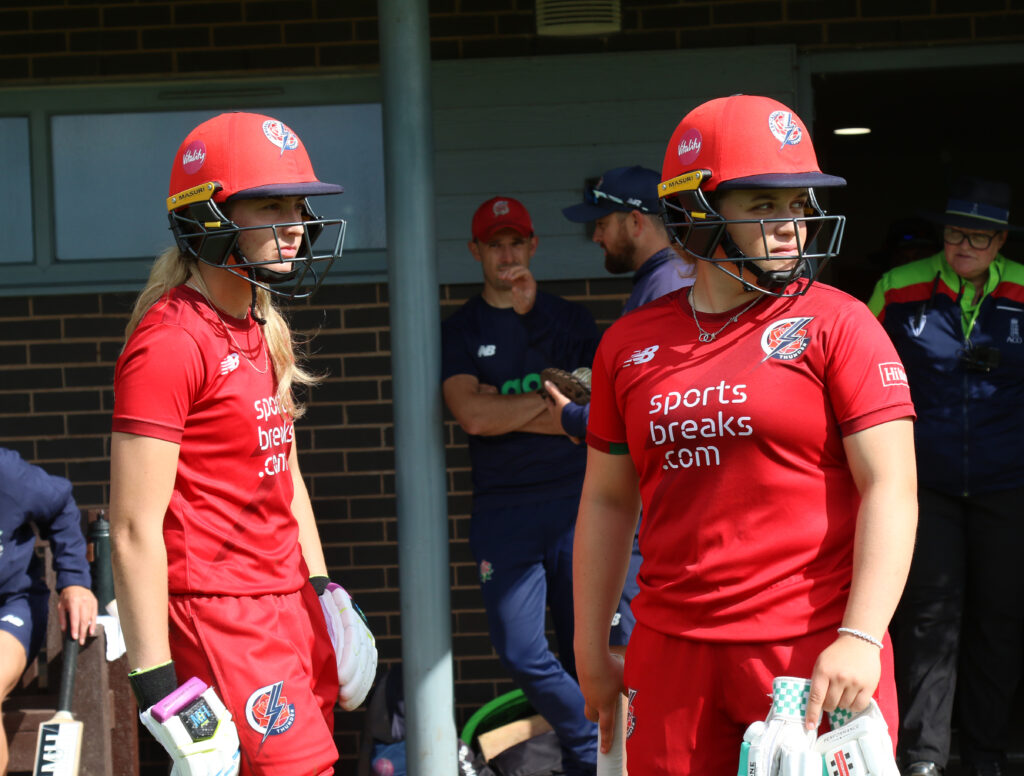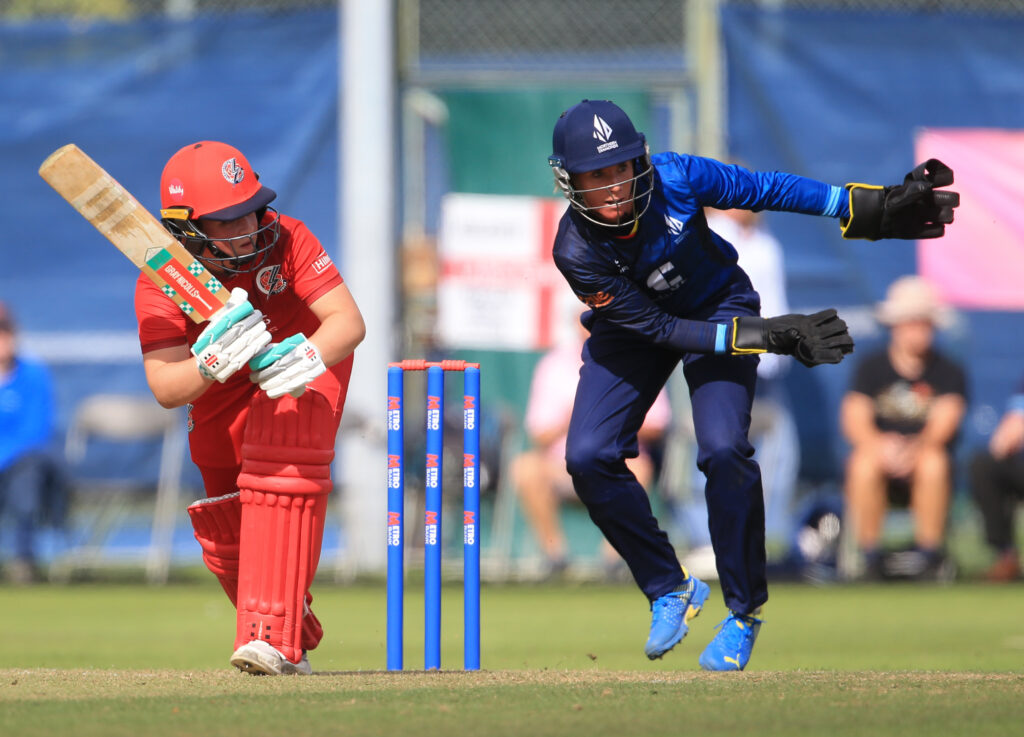“They play cricket whereas I have to do gymnastics”: a glimpse into state school cricket
During secondary education, the closest England U19 cricketer Seren Smale got to a cricket P.E. lesson was at the school next door which taught outdoors on a multi-purpose artificial turf pitch.
Travel 42 miles south though, and you’ll find Shrewsbury School teaching cricket in a state-of-the-art indoor cricket centre.
In fact, private school attendees are nearly three times more likely to play cricket during school hours than state school attendees in the UK.
Sport England data shows just 5.4% of children and young people who attend state-funded schools have played cricket in school hours, compared to 14% (2.6 times more) for those who attended private school.
These figures starkly contrast those of football. Over a third of state school children and young people play football with a negligible difference between state-funded and private schools.

So, provision of cricket in schools is not only scarce, but sharply unequal across state-funded and private schools.
“You just know that [private school attendees] are getting training when they go back to school whereas I’ve got to do gymnastics on Wednesday instead of playing cricket,” said Smale who kept wicket in England’s ICC Under-19 T20 World Cup 2023 campaign.
“You’ve got to go to your club for cricket nets. It’s a bit more of a faff. Whereas at private school, yeah you don’t want to be there all the time, but you have still got the option and easy access.”
Born in Wrexham, 19-year-old Smale went through the Welsh education system and attended Ysgol Maes Garmon, a small secondary school in North Wales.
As is the norm, Ysgol Maes Garmon did not teach cricket in P.E. lessons and was without cricket-specific facilities such as indoor or outdoor nets, or a pitch.
Notably, the state-funded school next door, the Alun School which did offer cricket in P.E. lessons, was limited to using the neighbouring leisure centre’s multi-purpose artificial turf pitch.
It is difficult to imagine the Alun could compete with some private schools even boasting some of the country’s best cricket facilities and coaches.
Besides provision being unequal in quantity, it is also unequal in quality too.

That being said, Smale herself turned down the opportunity of a scholarship to a private ‘cricketing’ school.
“To be honest, I hated school, so I was never going to go to one of these schools and get a scholarship. It just was not for me.
“I was quite happy and had a lot of support around me from my coach, and Wales and Lancashire which I was getting a lot of training from,” said Smale.
Training at Mold Cricket Club and the local MCCF Hub allowed Smale to progress up the talent pathway to county level at Wales and Lancashire, then to the North West Thunder Academy.
Now, with a Thunder professional contract and increasing appearances for England A under her belt, Smale admits that this is not financially feasible for everyone.
“If you’re in private school, you’re playing so much more cricket. They’ve got an extra little thing that they can do because they’re getting more training. Going to the MCCF Hub and training at my club helped me which not everyone can do.”
While the cost and time of playing cricket was not a significant barrier for Smale, for those who do not receive scholarships and are from a lower socio-economic background it is harder to progress up the talent pathway.
“I feel like I did quite well and [my progression] was quite easy, but sometimes for people who made the county squad but didn’t receive an invitation to the academy, it was harder to get recognition.
“There were not as many eyes on you. Especially if you’re not in let’s say for the sake of the argument ‘Shrewsbury school’, some wondered, ‘how am I going to get to that point if I’m not playing cricket all the time?” added Smale.
The elite level is no stranger to this inequity either. The ICEC report found 56.4% of male and female professional cricketers had attended private school at some point, compared with 7% of the general population.

As such, the wicketkeeper-batter has been a strong supporter of increasing, and removing barriers to, participation in cricket through leading her school’s involvement in cricket competitions and helping out at her local MCCF hub.
“I’d go, ‘Right who wants to get out of maths to come play some cricket?’ and take all my mates and as many girls as possible to the competitions.
“There were a few who played hockey so were naturally good and then some of my mates were absolutely dreadful, but they were just so funny.
“At one point it was, ‘we’ll do it to get out of Maths’, then the girls started asking ‘when’s the next round? Are we actually going to win?’ They got really into it, and the school always took us out which was good to see.”
By the time Smale finished secondary school, it was clear the competition’s standard had improved significantly with new schools entering too.
She hopes cricket is introduced in more P.E. lessons to capitalise on the growing demand and leave pupils with the happy cricket memories she left school with.
What is clear, however, is that the duty rests on policymakers to address the remaining issues of scarcity and inequity so everyone can enjoy the lovely game we call cricket.